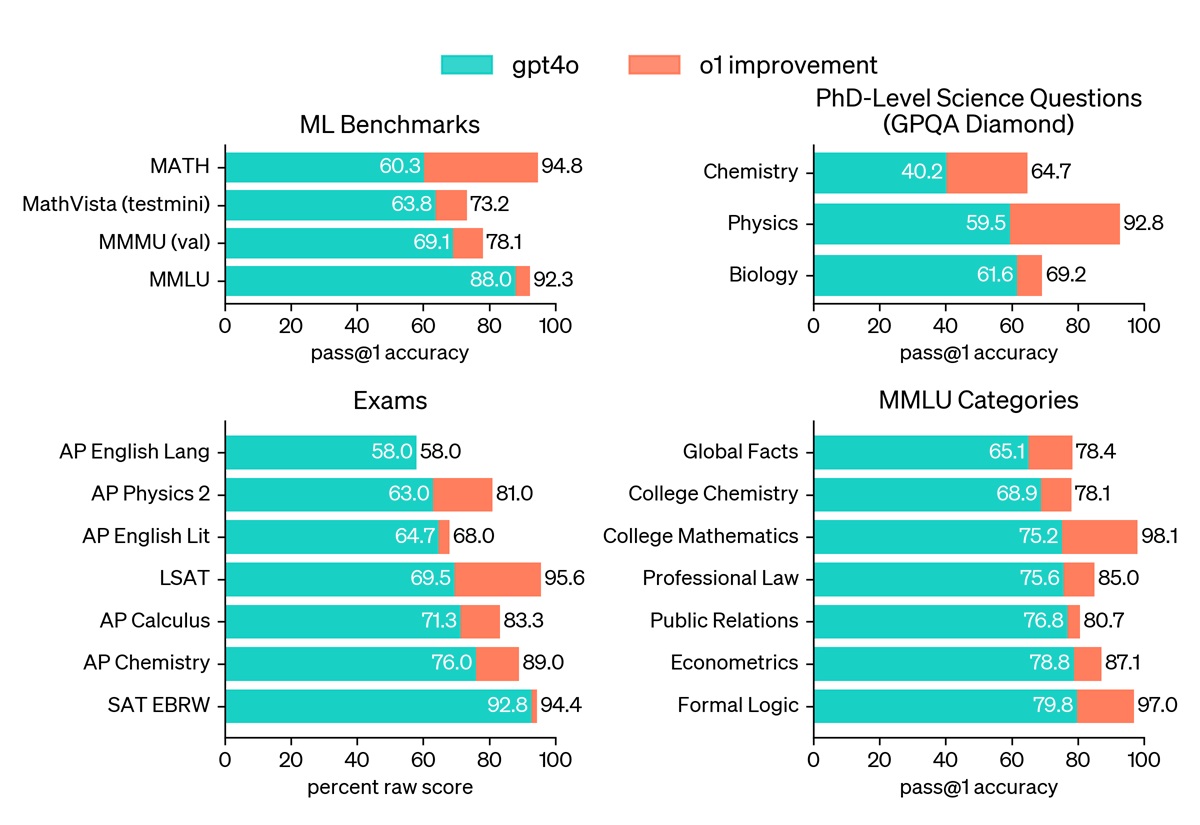In a major leap forward for artificial intelligence, OpenAI has introduced its cutting-edge large language model, OpenAI o1, which is engineered to excel at complex reasoning and problem-solving. This innovative AI employs reinforcement learning strategies that significantly enhance its ability to tackle intricate tasks across a range of domains, from competitive programming to scientific problem-solving.
A New Approach to AI Problem-Solving
The standout feature of OpenAI’s o1 model is its ability to generate an internal “chain of thought” before providing responses to users. This method allows the AI to mimic human cognitive processes, making it highly effective at solving complicated problems with more precision and depth. It marks a departure from traditional language model pretraining, shifting towards a more thoughtful, calculated approach to reasoning.
How o1 Impacts ChatGPT and GPT-4o
The introduction of OpenAI o1, particularly its o1-preview version, is poised to transform how AI models function in problem-solving. Here are key ways in which o1 stands apart from its predecessor, GPT-4o:
- Enhanced Reasoning Abilities: The o1 model excels at complex reasoning tasks, outperforming GPT-4o in subjects like mathematics, science, and coding. This makes it more suitable for advanced applications requiring detailed analysis and logical thinking.
- Longer Response Times: While o1-preview may provide more thoughtful responses, it tends to take longer to answer due to its extended thinking process. This trade-off comes with the benefit of more accurate and thorough problem-solving.
- Feature Limitations: o1-preview lacks some features present in GPT-4o, such as web browsing and file uploads. For tasks requiring these capabilities, GPT-4o may still be the go-to option for certain users.
- Cost Implications: Running o1-preview comes at a higher cost compared to GPT-4o, as it consumes more computational resources per input and output token. This could limit accessibility for some users, making GPT-4o more affordable for general use.
- Future Integration: OpenAI may integrate the advanced reasoning capabilities of o1 into future versions of ChatGPT, potentially combining the strengths of both models for even more powerful AI tools.
Impressive Performance in Competitive Programming
One of the areas where o1 has truly shone is competitive programming. In rigorous tests, o1 has outperformed many human competitors on platforms such as Codeforces and has achieved strong results in math competitions:
- Codeforces: o1 achieved an Elo rating of 1807, placing it in the top 11% of global participants and outperforming 93% of human competitors.
- International Olympiad in Informatics (IOI): A specialized version of o1 scored 213 points, ranking in the 49th percentile. With relaxed constraints, o1 improved its score to 362.14, surpassing the gold medal threshold.
- Mathematics Olympiad: In a recent test, o1 solved 83% of problems in a qualifying exam, compared to GPT-4o’s success rate of just 13%.
These achievements highlight the model’s strong problem-solving abilities and its capacity to compete with human programmers and mathematicians on highly challenging tasks.
o1’s Capabilities Across Domains
The performance of OpenAI o1 has been validated across a diverse range of benchmarks that include both reasoning and practical problem-solving tasks:
- Competitive Programming: Ranked in the 89th percentile on Codeforces.
- Mathematics: Ranked among the top 500 in the USA Math Olympiad qualifiers.
- Scientific Problem-Solving: Achieved PhD-level accuracy in tasks involving physics, biology, and chemistry through the GPQA benchmark.
This versatility, coupled with its ability to reason through complex problems, makes o1 one of the most advanced AI models to date.
Key Innovations Behind o1’s Success
The success of o1 is attributed to its reinforcement learning algorithm, which focuses on two main factors to boost performance:
- Extended Training: Increasing the amount of reinforcement learning during training allows the model to improve its understanding of complex tasks.
- Increased Thinking Time: By allocating more time for thought processes during real-time problem-solving, o1 consistently delivers more accurate and in-depth results.
This new methodology represents a departure from the standard training of language models, providing a blueprint for future advancements in AI.
Comparison to GPT-4o
When compared to GPT-4o, o1 has demonstrated a clear edge in tasks requiring deep reasoning:
- In the AIME 2024, o1 solved 93% of math problems using advanced techniques, significantly outperforming GPT-4o’s 12%.
- In the GPQA Diamond challenge, o1 surpassed human PhD experts, a first for any AI model.
- In reasoning-intensive subcategories of MMLU, o1 outperformed GPT-4o in 54 out of 57 tasks.
However, it is worth noting that o1 has some room for improvement in natural language tasks, where GPT-4o still performs better in specific scenarios.
As OpenAI continues to develop and refine the o1 model, its impact on the AI landscape will likely be profound. With its groundbreaking abilities in reasoning and problem-solving, o1-preview sets a new standard for large language models. Over time, as OpenAI integrates these capabilities into broader platforms like ChatGPT, we can expect even more sophisticated and intelligent AI solutions.


